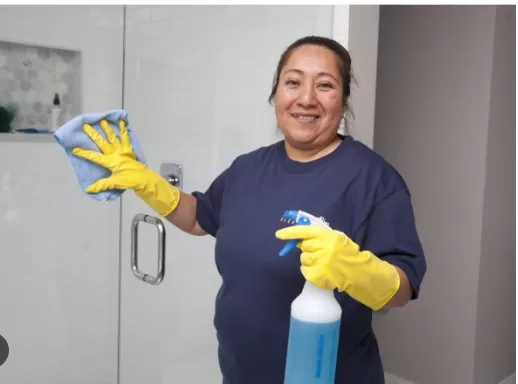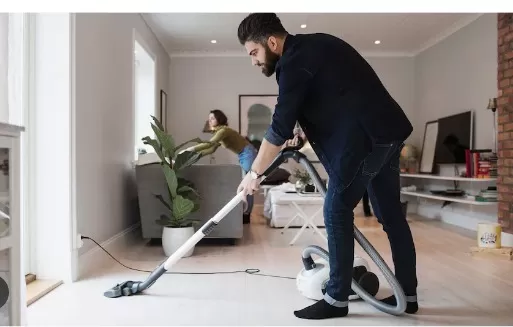Common Cleaning Mistakes: Errors Everyone Makes. Cleaning the house is a regular chore, but it’s important to do it right. Avoid these common cleaning mistakes and learn how to fix them for a more effective cleaning routine.
First, don’t overlook the power of using the right cleaning products for specific surfaces and materials. Using the wrong product can damage or leave streaks. Additionally, avoid using too much cleaning solution or detergent, as it can create residue that is difficult to remove. Another mistake is neglecting to clean high-touch areas and commonly overlooked spots like doorknobs, light switches, and baseboards. These areas harbor germs and dust that can spread throughout the house. Don’t forget to clean and replace your cleaning tools regularly, such as sponges, mops, and vacuum filters, as they can accumulate dirt and bacteria. Lastly, rushing through the cleaning process can lead to missed spots and inadequate cleaning. Take your time and be thorough in each area. By avoiding these cleaning mistakes and making necessary adjustments, you’ll achieve a cleaner and more enjoyable living environment.
Revamp Your Cleaning Habits: A Guide to Improving Your Home Cleaning Routine

When it comes to cleaning our homes, we often fall into familiar routines without questioning if there’s a better way.
Little do we know that there are correct and incorrect methods for dusting, mopping, scrubbing, vacuuming, and cleaning various items around the house. If you’re concerned that you may have been doing it wrong all this time, worry not! In this article, we’ll highlight the most common cleaning mistakes and provide solutions to help you improve your cleaning habits.
Keep reading to discover how to enhance your cleaning routine and achieve better results.
Minimizing the Use of Furniture Polish for Dusting
While furniture polish can leave a pleasant scent and give your cabinets a glossy appearance, it’s important to use it in moderation.
Many commercial furniture polishes contain a high concentration of oil, which can lead to smearing and make fingerprints more noticeable. As a general rule, a cloth lightly dampened with water is often sufficient for regular cleaning and maintenance purposes. By adopting this approach, you can effectively reduce your reliance on furniture polish while still achieving satisfactory results.
Removing Stains from Carpet and Upholstery: A Gentle Approach

Stains are an inevitable part of life, even finding their way into our carpets and upholstery.
However, it’s crucial to resist the temptation to vigorously scrub the stain, as this can harm the fibers. Instead, opt for a more gentle approach by following these steps:.
Act quickly: As soon as the stain occurs, grab a clean, dry towel and gently blot the area to absorb as much of the spill as possible.
Avoid rubbing or scrubbing, as this can push the stain deeper into the fabric.
Rinse with water: Once you’ve blotted up the excess liquid, rinse the stained area thoroughly with Clean Water.
You can use a spray bottle or a damp cloth to apply the water evenly. Blot with a clean towel to remove the moisture.
Repeat as needed: If the stain persists, repeat the blotting and rinsing process until the stain starts to fade.
Be patient and avoid using excessive force.
Consider stain remover: If necessary, apply a carpet or upholstery stain remover according to the manufacturer’s instructions.
Be sure to test the product on a small, inconspicuous area first to ensure it doesn’t cause any discoloration or damage.
By adopting this gentle stain removal method, you can effectively tackle stains on your carpet and upholstery while preserving their integrity and appearance.
Optimal Timing for Window Cleaning: Choose a Cloudy Day
While it may seem intuitive to clean your windows on a sunny day for better visibility, it’s important to be aware of potential cleaning mistakes.
Cleaning windows under direct sunlight can lead to streaks due to the rapid evaporation of glass cleaner. To achieve a spotless and streak-free result, it is recommended to wait for a cloudy day with temperatures below 70 degrees Fahrenheit. During such conditions, the glass cleaner will have ample time to effectively clean the windows without evaporating too quickly, ensuring a clearer and more satisfactory outcome. So, when it comes to window cleaning, choose a cloudy day to maximize your chances of achieving streak-free, crystal-clear windows while avoiding common cleaning mistakes.
Cautions When Cleaning Electronics: Avoid Spray Cleaners

When it comes to cleaning electronics such as TVs, cell phones, or LCD screens, it’s important to steer clear of using sprays like window cleaners.
These sprays can potentially cause damage to the delicate surfaces of electronic devices. Additionally, materials such as wood fibers from paper towels and tissues can also be harmful.
To ensure safe and effective cleaning, follow these guidelines:.
Opt for a microfiber cloth: Instead of using sprays, use a soft microfiber cloth to gently clean the surfaces of your electronic devices.
Microfiber cloths are designed to be gentle and non-abrasive, making them suitable for cleaning delicate screens.
Consider a coffee filter as an alternative: In the absence of a microfiber cloth, a coffee filter can be used as a substitute.
Coffee filters are typically lint-free and provide a soft and gentle cleaning surface.
Use rubbing alcohol if needed: If you require additional cleaning power, you can dampen the cloth (or coffee filter) with rubbing alcohol.
Ensure that the cloth is only slightly damp, not wet, to avoid any potential liquid damage.
Spray onto the cloth, not the screen: When using Cleaning Solutions like rubbing alcohol, always spray the solution onto the cloth directly, rather than spraying it directly onto the screen.
This prevents any excess liquid from seeping into the device and causing damage.
By adhering to these precautions and using appropriate cleaning materials, you can effectively clean your electronics without risking any harm or damage to the delicate surfaces.
*The information is for reference only.